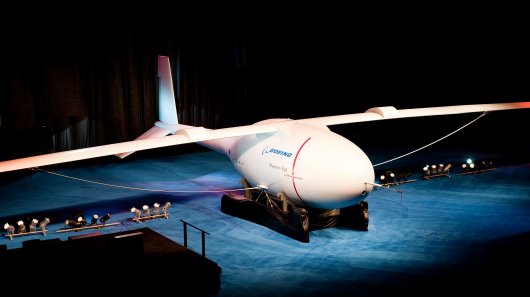
Unveiled earlier this week in St. Louis, Boeing's Phantom Eye will set a new benchmark in long-endurance unmanned aerial vehicle (UAV) technology when it takes to the skies in 2011. With a wing-span of 150-feet, the hydrogen-powered aircraft will cruise at 150 knots, carry up to 450-pounds and stay aloft at 65,000 feet for up to four days. Boeing calls it a game-changer, and plans are already in progress to build a bigger version that can remain airborne for 10 days.
The high-altitude long-endurance (HALE) Phantom Eye is powered by two highly-efficient, 2.3-liter, four-cylinder Ford Ranger truck engines that run on hydrogen and emit only water. Ford began working on this technology about a decade ago.
The Global Hawk UAV can fly non-stop for more than 30 hours and the solar-powered Qinetiq’s Zephyr has recorded 82 hours 37 minutes aloft. The Phantom Eye will surpass both these marks if it achieves its four day endurance goal, providing a long-term communication station above the battlefield and removing the need for having aircraft on the ground.
If the longer-term goal of ten days is reached, Boeing believes the need for global basing and supply chain of communications and surveillance aircraft can be eliminated. It's envisioned that three or four of these aircraft working together could provide 24-7 coverage of a site anywhere on the globe from a base inside the United States.
"Phantom Eye is the first of its kind and could open up a whole new market in collecting data and communications," Darryl Davis, president of Boeing Phantom Works, said today at the unveiling ceremony in St. Louis. "It is a perfect example of turning an idea into a reality. It defines our rapid prototyping efforts and will demonstrate the art-of-the-possible when it comes to persistent intelligence, surveillance and reconnaissance. The capabilities inherent in Phantom Eye's design will offer game-changing opportunities for our military, civil and commercial customers."
In coming months, the Phantom Eye technology demonstrator (which was produced in just 27 months) will make its way to NASA’s Dryden Flight Research Center in California for ground and taxi tests before test flight get underway on early 2011. Boeing expects that the fist flight will last four to eight hours.
Boeing has developed the project in conjunction with Ford; Aurora Flight Sciences (wing); Mahle Powertrain (propulsion controls); Ball Aerospace (fuel tanks); Turbosolutions Engineering (turbochargers); the Defense Advanced Research Projects Agency; and NASA.
Copyright © gizmag 2003 - 2010 To subscribe or visit go to: http://www.gizmag.com